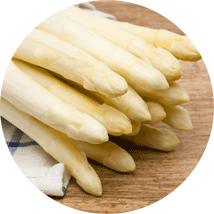
Botanical Name: Asparagus officinalis, is a member of the Liliaceae family.
Common Name: White gold, edible ivory, also referred to as the royal vegetable.
Dirt is kept mounded around the emerging stalk, depriving it of light. The plant cannot produce chlorophyll without light, thus there is no green colour to the stalks. The much rarer white asparagus has a milder flavour and a softer texture. Farmers cover the stalks with soil as they grow, which prevents sunlight from reaching the shoots. This retards the development of chlorophyll (which makes plants green), resulting in the delicate creamy colour.
White asparagus is more tender, and has its own distinct aroma. Unlike its green-skinned counterpart, white asparagus has a tough, bitter peel that must be removed before cooking.